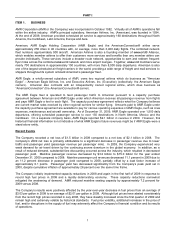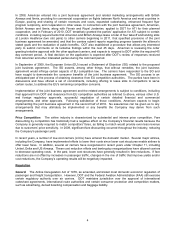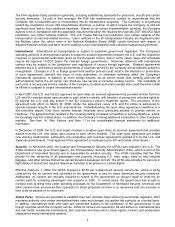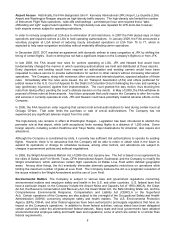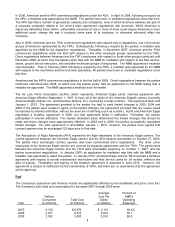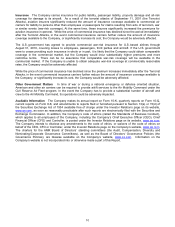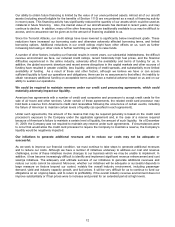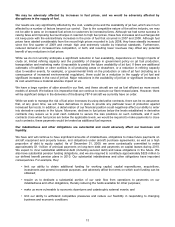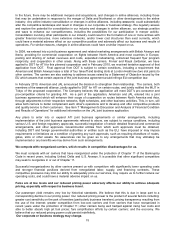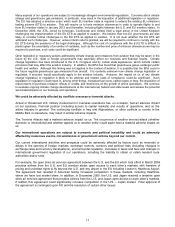American Airlines 2009 Annual Report Download - page 14
Download and view the complete annual report
Please find page 14 of the 2009 American Airlines annual report below. You can navigate through the pages in the report by either clicking on the pages listed below, or by using the keyword search tool below to find specific information within the annual report.
11
ITEM 1A. RISK FACTORS
Our ability to become profitable and our ability to continue to fund our obligations on an ongoing basis will depend
on a number of risk factors, many of which are largely beyond our control. Some of the factors that may have a
negative impact on us are described below:
As a result of significant losses in recent years, our financial condition has been materially weakened.
We incurred significant losses in recent years, which has materially weakened our financial condition. We lost
$893 million in 2005, $781 million in 2004, $1.2 billion in 2003, $3.5 billion in 2002 and $1.8 billion in 2001.
Although we earned a profit of $456 million in 2007 and $189 million in 2006, we lost $2.1 billion in 2008 (which
included a $1.2 billion impairment charge), and, primarily as a result of very weak demand for air travel driven by
the severe downturn in the global economy, we lost $1.5 billion in 2009. Because of our weakened financial
condition, we are vulnerable both to the impact of unexpected events (such as terrorist attacks) and to
deterioration of the operating environment (such as a deepening of the current global recession, a significant
increase in jet fuel prices or significant increased competition).
The severe global economic downturn has resulted in very weak demand for air travel and lower
investment asset returns, which has had and could continue to have a significant negative impact on us.
We are experiencing very weak demand for air travel driven by the severe downturn in the global economy. Many
of the countries we serve are experiencing economic slowdowns or recessions. We began to experience
weakening demand late in 2008, and this weakness has continued into 2010. We reduced capacity in 2008, and
in the first half of 2009 we announced additional reductions to our capacity plan. In connection with these capacity
reductions, the Company incurred special charges related to aircraft, employee reductions and certain other
charges. If the global economic downturn persists or worsens, demand for air travel may continue to weaken. No
assurance can be given that capacity reductions or other steps we may take will be adequate to offset the effects
of reduced demand. Such capacity reductions or other steps might result in additional special charges in the
future. Further, other carriers may not reduce capacity or may increase capacity, which may reduce the expected
benefits of our capacity reductions.
The economic downturn has resulted in broadly lower investment asset returns and values. Our pension assets
suffered a material decrease in value in 2008 related to broader stock market declines, which resulted in higher
pension expense in 2009 and will result in higher pension expense and higher required contributions in future
years. In addition, under these unfavorable economic conditions, we may be required to maintain cash reserves
under our credit card processing agreements and the potential obligation to post cash collateral on fuel hedging
contracts. These issues individually or collectively may have a material adverse impact on our liquidity. Also,
disruptions in the capital markets and other sources of funding may make it impossible for us to obtain necessary
additional funding or make the cost of that funding prohibitive.
We face numerous challenges as we seek to maintain sufficient liquidity, and we will need to raise
substantial additional funds. We may not be able to raise those funds, or to do so on acceptable terms.
We have significant debt, lease and other obligations in the next several years, including significant pension
funding obligations. In 2010, we will be required to make approximately $1.0 billion of principal payments on long-
term debt and approximately $90 million in principal payments on capital leases, and we expect to spend
approximately $2.1 billion on capital expenditures, including aircraft commitments. In addition, in 2010, we are
required to contribute approximately $525 million to our defined benefit pension plans. Moreover, the global
economic downturn, rising fuel prices, the potential obligation to post reserves under credit card processing
agreements and the potential obligation to post cash collateral on fuel hedging contracts, among other things,
have negatively impacted, and may in the future negatively impact, our liquidity. To meet our commitments and to
maintain sufficient liquidity as we continue to implement our revenue enhancement and cost reduction initiatives,
we will need continued access to substantial additional funding. Moreover, while we have arranged financings
that, subject to certain terms and conditions (including, in the case of financing arrangements covering a
significant number of aircraft, a condition that, at the time of borrowing, we have a certain amount of unrestricted
cash and short term investments), cover all of our aircraft delivery commitments through 2011, we will continue to
need to raise substantial additional funds to meet our commitments.


